2008 KIA Opirus seats
[x] Cancel search: seatsPage 42 of 283
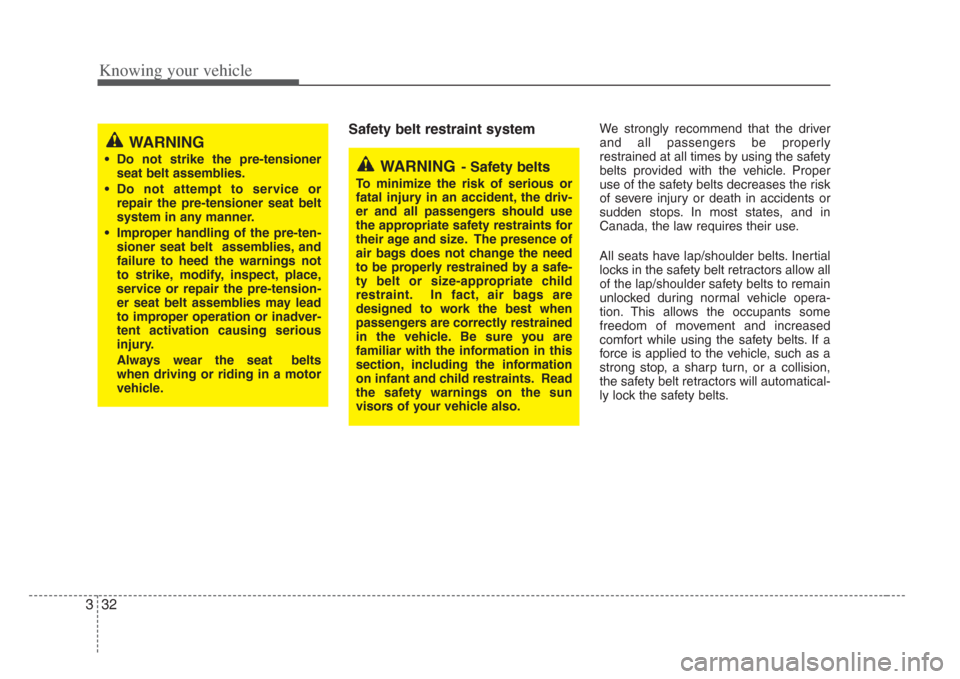
Knowing your vehicle
323
Safety belt restraint system We strongly recommend that the driver
and all passengers be properly
restrained at all times by using the safety
belts provided with the vehicle. Proper
use of the safety belts decreases the risk
of severe injury or death in accidents or
sudden stops. In most states, and in
Canada, the law requires their use.
All seats have lap/shoulder belts. Inertial
locks in the safety belt retractors allow all
of the lap/shoulder safety belts to remain
unlocked during normal vehicle opera-
tion. This allows the occupants some
freedom of movement and increased
comfort while using the safety belts. If a
force is applied to the vehicle, such as a
strong stop, a sharp turn, or a collision,
the safety belt retractors will automatical-
ly lock the safety belts.
WARNING
• Do not strike the pre-tensioner
seat belt assemblies.
• Do not attempt to s ervice or
repair the pre-tensioner seat belt
system in any manner.
• Improper handling of the pre-ten- sioner seat belt assemblies, and
failure to heed the warning s not
to strike, modify, inspect, place,
service or repair the pre-tension-
er seat belt assemblies may lead
to improper operation or inadver-
tent activation caus ing serious
injury.
Always wear the seat belts
when driving or riding in a motor
vehicle.WARNING- Safety belts
To minimize the risk of serious or
fatal injury in an accident, the driv-
er and all passenger s should use
the appropriate safety restraints for
their age and size. The presence of
air bags does not change the need
to be properly restrained by a safe-
ty belt or s ize-appropriate child
res traint. In fact, air bags are
designed to work the be st when
passenger s are correctly re strained
in the vehicle. Be s ure you are
familiar with the information in this
section, including the information
on infant and child re straints. Read
the safety warnings on the sun
visor s of your vehicle also.
Page 51 of 283
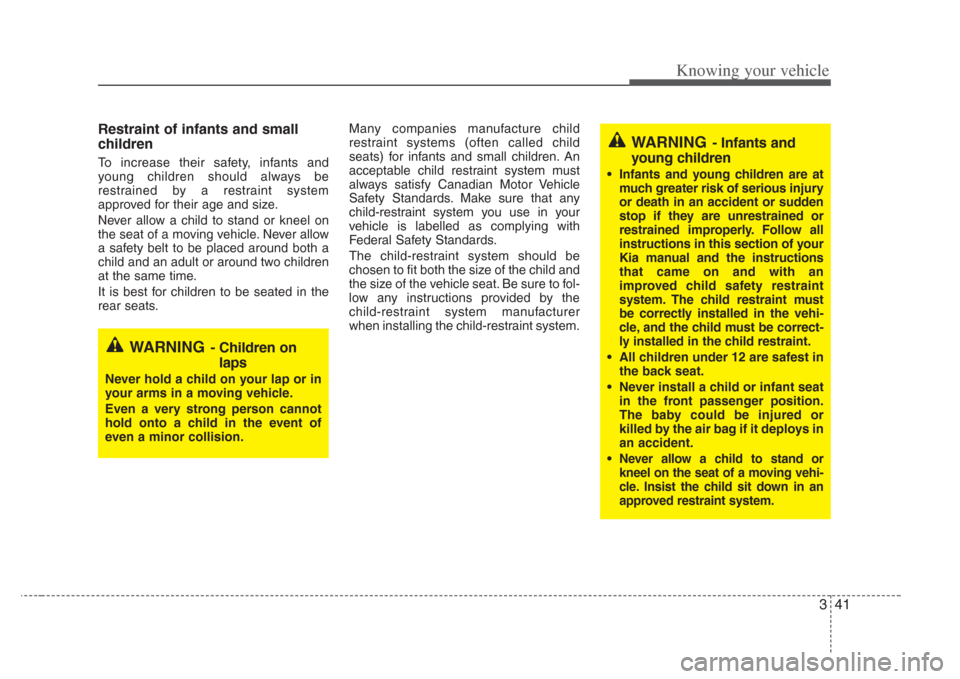
341
Knowing your vehicle
Restraint of infants and small
children
To increase their safety, infants and
young children should always be
restrained by a restraint system
approved for their age and size.
Never allow a child to stand or kneel on
the seat of a moving vehicle. Never allow
a safety belt to be placed around both a
child and an adult or around two children
at the same time.
It is best for children to be seated in the
rear seats. Many companies manufacture child
restraint systems (often called child
seats) for infants and small children. An
acceptable child restraint system must
always satisfy Canadian Motor Vehicle
Safety Standards. Make sure that any
child-restraint system you use in your
vehicle is labelled as complying with
Federal Safety Standards.
The child-restraint system should be
chosen to fit both the size of the child and
the size of the vehicle seat. Be sure to fol-
low any instructions provided by the
child-restraint system manufacturer
when installing the child-restraint system.
WARNING- Children on
laps
Never hold a child on your lap or in
your arms in a moving vehicle.
Even a very strong per son cannot
hold onto a child in the event of
even a minor collision.
WARNING- Infants and
young children
• Infants and young children are at
much greater ris k of serious injury
or death in an accident or s udden
s top if they are unres trained or
res trained improperly. Follow all
ins tructions in this s ection of your
Kia manual and the ins tructions
that came on and with an
improved child s afety restraint
s ystem. The child res traint must
be correctly ins talled in the vehi-
cle, and the child mus t be correct-
ly in stalled in the child res traint.
• All children under 12 are safest in the back seat.
• Never install a child or infant seat in the front passenger position.
The baby could be injured or
killed by the air bag if it deploys in
an accident.
•
Never allow a child to s tand or
kneel on the s eat of a moving vehi-
cle. In sis t the child s it down in an
approved res traint system.
Page 52 of 283

Knowing your vehicle
423
Restraint of larger children
As children grow, they may need to use
new child-restraint systems, including
larger child seats or booster seats, which
are appropriate for their increased size.
A child who has outgrown available child-
restraint systems should use the belts
provided in the vehicle. When seated in
the rear outboard seats, the child should
be restrained by the lap/shoulder belt.
If the shoulder belt portion slightly touch-
es the child’s neck or face, try placing the
child closer to the center of the vehicle. If
the shoulder belt still touches their face
or neck they may need to be returned to
a child restraint system. In addition, after-
market devices are available from inde-
pendent manufacturers which help pull
the shoulder belt down and away from
the child’s face or neck.
Larger children should use one of the
seat belts provided.WARNING- Shoulder belts
on small children
• Never allow a shoulder belt to be
in contact with a child’ s neck or
face while the vehicle is in
motion.
• If safety belt s are not properly
worn and adjusted, there is a risk
of death or serious injury to a
child.
WARNING- Hot metal parts
Safety belts and seats can become
hot in a vehicle that has been
clo sed during warm/hot weather;
they could burn a child. Check seat
cover s and buckles before you
place a child anywhere near them.
Page 53 of 283
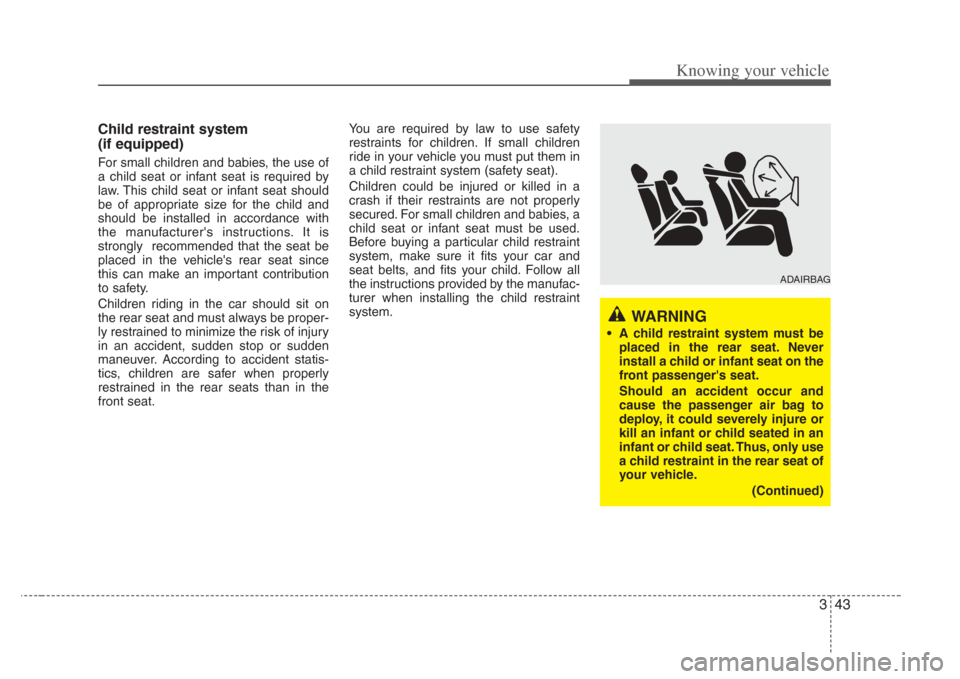
343
Knowing your vehicle
Child restraint system
(if equipped)
For small children and babies, the use of
a child seat or infant seat is required by
law. This child seat or infant seat should
be of appropriate size for the child and
should be installed in accordance with
the manufacturer's instructions. It is
strongly recommended that the seat be
placed in the vehicle's rear seat since
this can make an important contribution
to safety.
Children riding in the car should sit on
the rear seat and must always be proper-
ly restrained to minimize the risk of injury
in an accident, sudden stop or sudden
maneuver. According to accident statis-
tics, children are safer when properly
restrained in the rear seats than in the
front seat. You are required by law to use safety
restraints for children. If small children
ride in your vehicle you must put them in
a child restraint system (safety seat).
Children could be injured or killed in a
crash if their restraints are not properly
secured. For small children and babies, a
child seat or infant seat must be used.
Before buying a particular child restraint
system, make sure it fits your car and
seat belts, and fits your child. Follow all
the instructions provided by the manufac-
turer when installing the child restraint
system.
ADAIRBAG
WARNING
• A child restraint
system must be
placed in the rear s eat. Never
install a child or infant seat on the
front passenger's seat.
Should an accident occur and
cause the passenger air bag to
deploy, it could severely injure or
kill an infant or child seated in an
infant or child seat. Thus, only use
a child restraint in the rear seat of
your vehicle.
(Continued)
Page 55 of 283
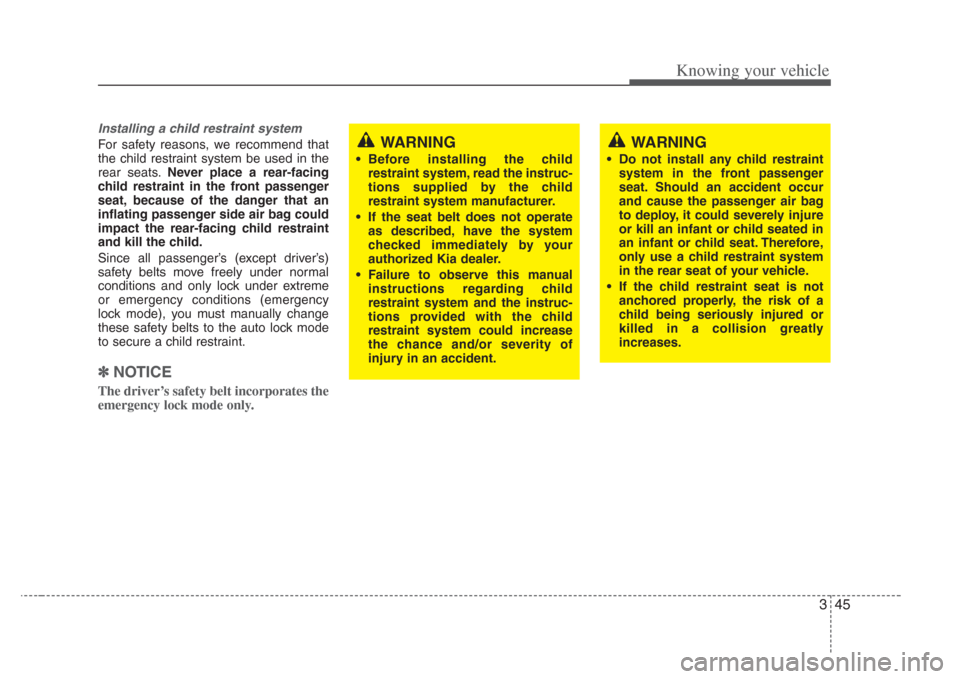
345
Knowing your vehicle
Installing a child restraint system
For safety reasons, we recommend that
the child restraint system be used in the
rear seats.Never place a rear-facing
child restraint in the front passenger
seat, because of the danger that an
inflating passenger side air bag could
impact the rear-facing child re straint
and kill the child.
Since all passenger’s (except driver’s)
safety belts move freely under normal
conditions and only lock under extreme
or emergency conditions (emergency
lock mode), you must manually change
these safety belts to the auto lock mode
to secure a child restraint.
✽ NOTICE
The driver’s safety belt incorporates the
emergency lock mode only.
WARNING
• Do not install any child restraint
system in the front passenger
seat. Should an accident occur
and cause the passenger air bag
to deploy, it could severely injure
or kill an infant or child seated in
an infant or child seat. Therefore,
only use a child restraint system
in the rear seat of your vehicle.
• If the child restraint seat is not
anchored properly, the ri sk of a
child being seriously injured or
killed in a collis ion greatly
increases.
WARNING
• Before ins talling the child
restraint system, read the instruc-
tions supplied by the child
restraint system manufacturer.
• If the seat belt does not operate as described, have the system
checked immediately by your
authorized Kia dealer.
• Failure to observe this manual ins tructions regarding child
restraint system and the instruc-
tions provided with the child
restraint system could increase
the chance and/or s everity of
injury in an accident.
Page 56 of 283
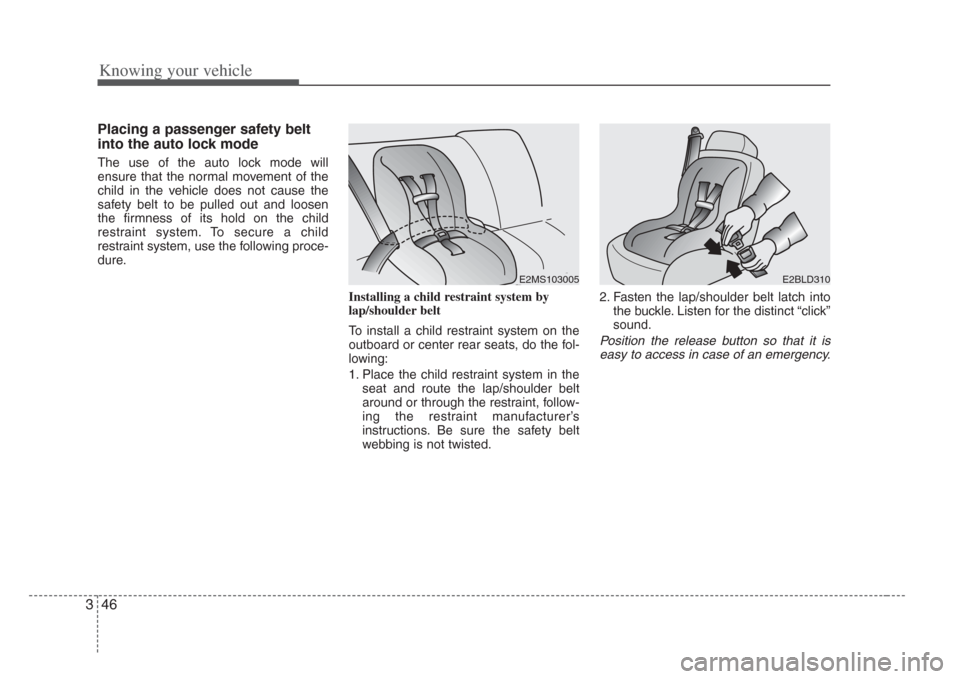
Knowing your vehicle
463
Placing a passenger safety belt
into the auto lock mode
The use of the auto lock mode will
ensure that the normal movement of the
child in the vehicle does not cause the
safety belt to be pulled out and loosen
the firmness of its hold on the child
restraint system. To secure a child
restraint system, use the following proce-
dure.
Installing a child restraint system by
lap/shoulder belt
To install a child restraint system on the
outboard or center rear seats, do the fol-
lowing:
1. Place the child restraint system in theseat and route the lap/shoulder belt
around or through the restraint, follow-
ing the restraint manufacturer’s
instructions. Be sure the safety belt
webbing is not twisted. 2. Fasten the lap/shoulder belt latch into
the buckle. Listen for the distinct “click”
sound.
Position the release button so that it iseasy to access in case of an emergency.
E2MS103005E2BLD310
Page 58 of 283

Knowing your vehicle
483
✽NOTICE
When the safety belt is allowed to
retract to its fully stowed position, the
retractor will automatically switch from
the “Auto Lock” mode to the emergency
lock mode for normal adult usage.
Securing a child re straint seat with
“Tether Anchor” system
Child restraint hook holders are located
on the shelf behind the rear seats.
1. Open the tether anchor cover on the
shelf behind the rear seats. 2. Route the child restraint seat strap
over the seatback.
For vehicles with adjustable headrest,
route the tether strap under the head-
rest and between the headrest posts,
otherwise route the tether strap over
the top of the seatback.
3. Connect the tether strap hook to the correct child restraint hook holder and
tighten to secure the seat.
WARNING- Auto lockmode
The lap/shoulder belt automatically
returns to the “emergency lock
mode” whenever the belt i s allowed
to retract fully. Therefore, the pre-
ceding seven steps mu st be fol-
lowed each time a child re straint is
installed.
If the s afety belt is not placed in the
“auto lock” mode, severe injury or
death could occur to the child
and/or other occupants in the vehi-
cle in a collis ion,since the child
res traint will not be effectively held
in place.
6GHA2025OGH036330N
Page 59 of 283
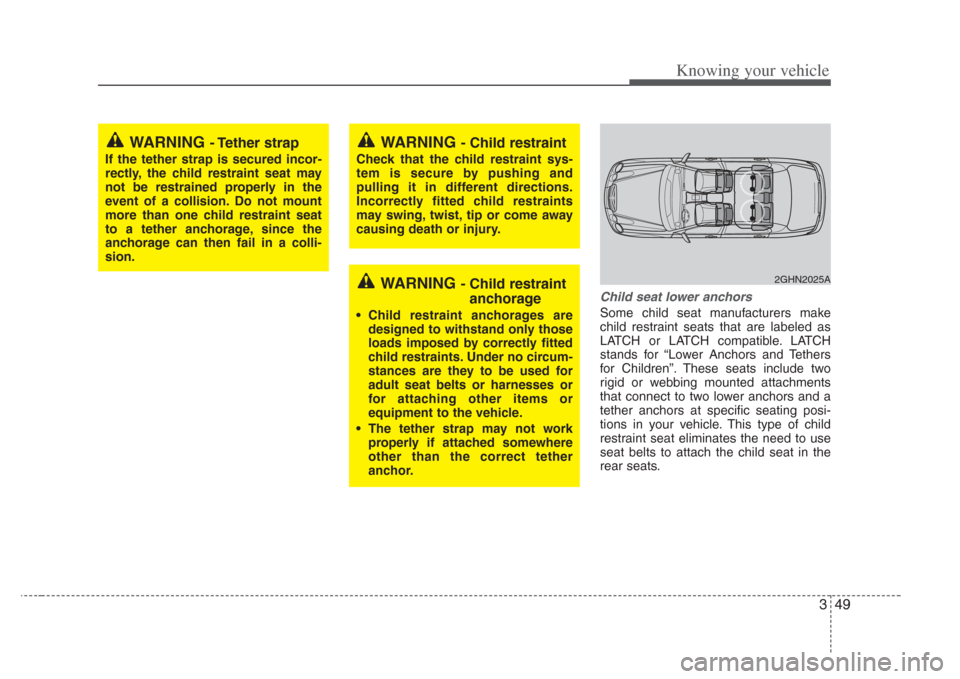
349
Knowing your vehicle
Child seat lower anchor s
Some child seat manufacturers make
child restraint seats that are labeled as
LATCH or LATCH compatible. LATCH
stands for “Lower Anchors and Tethers
for Children”. These seats include two
rigid or webbing mounted attachments
that connect to two lower anchors and a
tether anchors at specific seating posi-
tions in your vehicle. This type of child
restraint seat eliminates the need to use
seat belts to attach the child seat in the
rear seats.
WARNING - Tether strap
If the tether strap is secured incor-
rectly, the child restraint seat may
not be restrained properly in the
event of a collision. Do not mount
more than one child re straint seat
to a tether anchorage, since the
anchorage can then fail in a colli-
sion.
2GHN2025A
WARNING - Child restraint
Check that the child restraint sys-
tem is secure by pus hing and
pulling it in different directions .
Incorrectly fitted child res traints
may swing, twist, tip or come away
causing death or injury.
WARNING - Child restraint anchorage
• Child res traint anchorages are
designed to withstand only tho se
loads imposed by correctly fitted
child restraints. Under no circum-
stances are they to be used for
adult seat belts or harnesses or
for attaching other items or
equipment to the vehicle.
• The tether strap may not work
properly if attached somewhere
other than the correct tether
anchor.